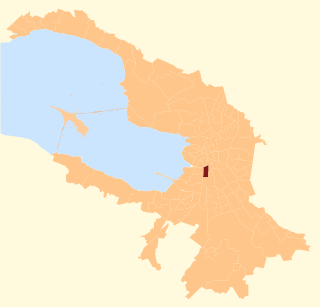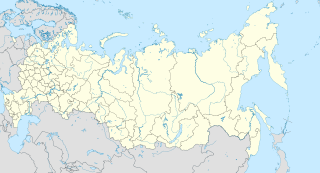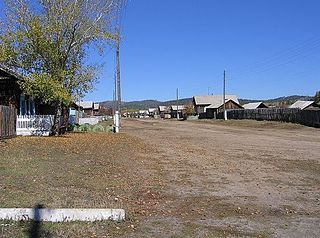Drakino is a rural locality in Liskinsky District of Voronezh Oblast, Russia.

Izmaylovskoye Municipal Okrug is a municipal okrug of Admiralteysky District of the federal city of St. Petersburg, Russia. Population: 26,355 (2010 Census); 30,415 (2002 Census).

Liteyny Municipal Okrug is a municipal okrug of Tsentralny District of the federal city of St. Petersburg, Russia. Population: 44,864 (2010 Census); 50,567 (2002 Census).

Vvedensky Municipal Okrug, formerly Municipal Okrug #58, is a municipal okrug of Petrogradsky District of the federal city of St. Petersburg, Russia. Population: 19,778 (2010 Census); 21,374 (2002 Census).

Serovo is a municipal settlement in Kurortny District of the federal city of St. Petersburg, Russia, located on the Karelian Isthmus, on the northern shore of the Gulf of Finland, where the Roshchinka River empties into the gulf. Population: 280 (2010 Census); 252 (2002 Census).

Levashovo is a municipal settlement under the administrative jurisdiction of Vyborgsky District of the federal city of St. Petersburg, Russia, and a station of the Riihimäki – Saint Petersburg Railway. Population: 3,665 (2010 Census); 4,095 (2002 Census).

Tungiro-Olyokminsky District is an administrative and municipal district (raion), one of the thirty-one in Zabaykalsky Krai, Russia. It is located in the northeast of the krai, and borders with Kalarsky District in the north, Mogochinsky District in the south, and with Tungokochensky District in the west. The area of the district is 42,900 square kilometers (16,600 sq mi). Its administrative center is the rural locality of Tupik. Population: 1,432 (2010 Census); 1,643 ; 1,899 (1989 Census). The population of Tupik accounts for 67.8% of the district's total population.

Khomutovka is an urban locality and the administrative center of Khomutovsky District of Kursk Oblast, Russia. Population: 4,230 (2010 Census); 5,050 (2002 Census); 5,578 (1989 Census). Telephone code: +7 47137; postal code: 307540.
Baleysky District is an administrative and municipal district (raion), one of the thirty-one in Zabaykalsky Krai, Russia. It is located in the southern central part of the krai, and borders Nerchinsky District in the north, Shelopuginsky District in the east, Borzinsky District in the south, and with Olovyanninsky District in the west. The area of the district is 5,000 square kilometers (1,900 sq mi). Its administrative center is the town of Baley. As of the 2010 Census, the total population of the district was 20,500, with the population of Baley accounting for 61.1% of that number.
Kalgansky District is an administrative and municipal district (raion), one of the thirty-one in Zabaykalsky Krai, Russia. It is located in the southeast of the krai and borders Nerchinsko-Zavodsky District in the north, Priargunsky District in the south, and Alexandrovo-Zavodsky District in the west. The area of the district is 2,900 square kilometers (1,100 sq mi). Its administrative center is the rural locality of Kalga. As of the 2010 Census, the total population of the district was 8,771, with the population of Kalga accounting for 39.1% of that number.
Shelopuginsky District is an administrative and municipal district (raion), one of the thirty-one in Zabaykalsky Krai, Russia. It is located in the center of the krai, and borders with Sretensky District in the north, Gazimuro-Zavodsky District in the east, Aleksandrovo-Zavodsky District in the south, and with Akshinsky District in the west. The area of the district is 3,900 square kilometers (1,500 sq mi). Its administrative center is the rural locality of Shelopugino. Population: 8,369 (2010 Census); 9,773 ; 13,124 (1989 Census). The population of Shelopugino accounts for 39.1% of the district's total population.
Tarbagatay is a rural locality in Tarbagataysky District of the Republic of Buryatia, Russia. Population: 4,308 (2010 Census); 4,246 (2002 Census);
Tarbagatay is a rural locality in Zaigrayevsky District of the Republic of Buryatia, Russia. Population: 30 (2010 Census); 52 (2002 Census);
Tarbagatay is a rural locality in Khorinsky District of the Republic of Buryatia, Russia. Population: 157 (2010 Census); 211 (2002 Census);
Putyatin is an urban locality under the administrative jurisdiction of the closed town of Fokino in Primorsky Krai, Russia. Population: 887 (2010 Census); 1,133 (2002 Census);

Kalga is a rural locality and the administrative center of Kalgansky District of Zabaykalsky Krai, Russia.
Dauriya is a settlement in Zabaykalsky District of Zabaykalsky Krai in Russia, the administrative center of the Daursky Rural Settlement.

Selyatino is an urban locality in Naro-Fominsky District of Moscow Oblast, Russia. Population: 12,629 (2010 Census); 13,062 (2002 Census);
Teploozyorsk is an urban locality in Obluchensky District of the Jewish Autonomous Oblast, Russia. Population: 4,311 (2010 Census); 5,124 (2002 Census); 5,775 (1989 Census).
Leninskoye is a rural locality (a and the administrative center of Leninsky District of the Jewish Autonomous Oblast, Russia. Population: 6,109 ; 7,048 ; 6,707 .
















